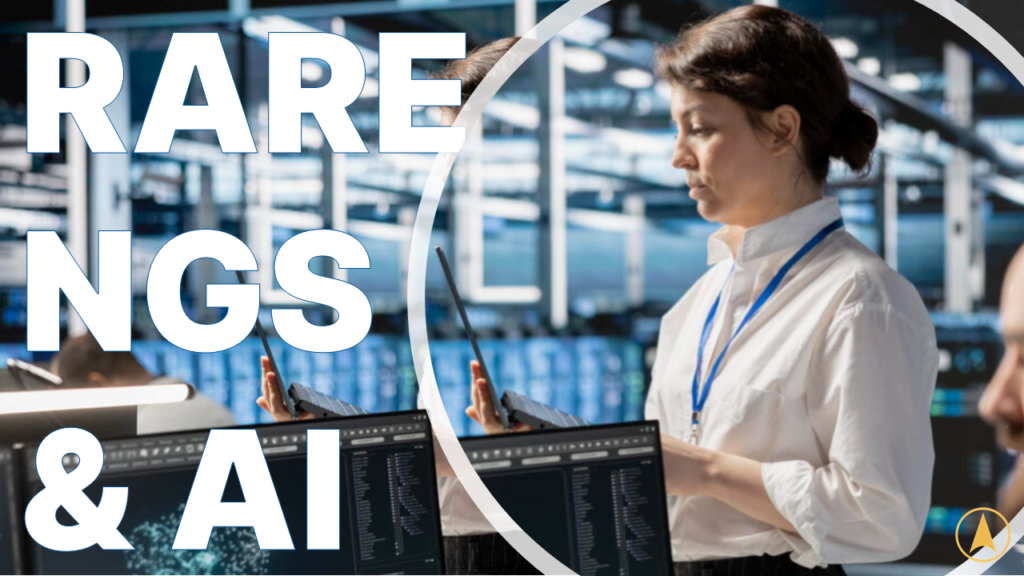Table of Contents
ToggleWhy Rare Disease Screening Matters
Rare diseases are individually uncommon, yet collectively affect 300 millions of people worldwide [1]. For many families, the journey to a diagnosis, often called the rare disease diagnostic odyssey — can take 5–7 years, with repeated referrals, inconclusive tests, and avoidable interventions [2].
| That delay is more than an inconvenience: it can mean missed treatment windows, uncertain reproductive planning, and significant emotional and financial stress [3].
Rare disease screening aims to shorten that journey by finding an underlying genetic cause early, ideally at the first clinical touchpoint [4]. Traditional workflows — single-gene tests or small targeted panels — help in specific scenarios but often miss atypical presentations and novel genes. Today, the combination of next-generation sequencing (NGS) and AI-enabled interpretation is changing the equation [5]. Together, they raise diagnostic yield, compress turnaround times, and make comprehensive testing feasible in real clinical settings [6].
Current Challenges in Rare Disease Screening
Scale of the problem:
| Though each disorder is uncommon, there are 7000+ of rare conditions, many with overlapping phenotypes [7]. Globally, rare diseases affect an estimated 300 million people [8].
Socioeconomic burden: Families face repeated clinic visits, fragmented testing, and prolonged uncertainty [9]. Health systems absorb costs from unnecessary imaging, hospital admissions, and inherited disease progression that could have been mitigated with earlier diagnosis [10].
Real-world stories like below, are all too familiar:
- A term newborn in a NICU, with refractory seizures had conventional metabolic workups, but imaging were nondiagnostic. Genome sequencing quickly identified a treatable metabolic disorder, and targeted therapy stabilized her seizures within days.
- A 38-year-old woman with progressive muscle weakness, cycled through multiple specialties and biopsies. Whole exome sequencing ultimately pinpointed a pathogenic variant in a neuromuscular gene, enabling appropriate supportive care and family carrier screening.
The Limitations of Traditional Screening
Sequential single-gene tests and small gene panels can be appropriate when the phenotypes are classic and the causative gene is well known [11]. However, these approaches have limited scope when symptoms are nonspecific or involve atypical genes or inheritance patterns [12].
- Time to diagnosis: Averages 5–7 years in many cohorts, prolonging uncertainty and delaying management.
- Coverage gaps: Conventional tests may overlook copy-number variants (CNVs), noncoding variants, and unexpected gene–phenotype relationships.
- Cost of serial testing: Repeating narrow tests over months or years is often more expensive than a one-time comprehensive analysis.
What Rare Diseases Are Difficult To Diagnose?
Disorders with variable expressivity (e.g., mitochondrial disease), overlapping phenotypes (e.g., syndromic neurodevelopmental conditions), and late-onset presentations (e.g., some cardiomyopathies) are frequently challenging without broad genomic approaches.
How To Get a Rare Disease Diagnosed?
A practical path is: comprehensive clinical evaluation, consideration of NGS-based testing (exome or genome) informed by phenotypes, multidisciplinary interpretation (genetics, specialty clinicians, genetic counseling), follow-up testing (segregation, functional assays) as needed.
How Next-Generation Sequencing (NGS) Transforms Screening
How Does NGS Improve Rare Disease Diagnosis?
By reading large portions of the genome at once, NGS can interrogate thousands of genes simultaneously, revealing single-nucleotide variants (SNVs), small insertions/deletions (INDELs), and, with appropriate pipelines, CNVs and other structural changes (SVs) [13].
|This broad scope raises diagnostic yield to roughly 25–50% in many rare disease cohorts (versus ~10–20% for older approaches), with the exact yield depending on phenotype and test type [14].
How NGS Works:
DNA is fragmented, copied many times, and “read” in parallel by the sequencer. Bioinformatics software aligns these reads to a reference genome and highlights differences, variants, for clinical interpretation [15]. → Read our depth NGS intro.
What Diseases Can Genome Sequencing Detect?
Genome sequencing can detect a wide array of inherited diseases, including metabolic, neuromuscular, neurodevelopmental, cardiac, renal, and syndromic conditions, provided a genetic basis exists and the variant type is within the assay’s detectable range.
- Newborns/NICU: Rapid exome/genome can reveal actionable inborn errors of metabolism, epileptic encephalopathies, and more.
- Neurology: From ataxias to peripheral neuropathies, broad testing unifies heterogeneous presentations.
- Oncology ([hereditary cancer)]: Germline panels or exome/genome identify inherited cancer predisposition and inform surveillance.
What Sequencing Test to Choose to Screen Diseases?
Clinically, it often means NGS-based testing (WES/WGS) paired with phenotype-driven analysis and confirmatory methods (e.g., Sanger) where indicated.
| Whole exome sequencing (WES) is efficient for coding variants across many genes; whole genome sequencing (WGS) offers more uniform coverage and better detection of noncoding and structural variants—often advantageous in WGS vs WES comparisons for rare disease diagnosis.
How Expensive is Genetic Sequencing?
Costs vary by region and technology, but prices have fallen substantially. Many systems now support affordable genetic testing through institutional programs or insurance coverage when clinical criteria are met.
What Conditions Does This Test Screen For?
The test can evaluate thousands of genes associated with hard-to-diagnose disorders, including metabolic syndromes, epilepsies, cardiomyopathies, primary immunodeficiencies, connective tissue disorders, and more. Laboratories typically provide an indicative rare disease list aligned with their validated gene set.
Clinical Applications & Use Cases
- Newborn screening programs: Pilot projects in the US and EU are exploring how NGS rare disease diagnoses can complement biochemical newborn screening, particularly for conditions where early therapy is crucial.
- Carrier screening for families: Expanded carrier screening identifies parental risk for autosomal-recessive and X-linked disorders, supporting reproductive planning.
- Prenatal testing: When ultrasound reveals anomalies or there is a relevant family history, exome/genome can clarify etiology and inform perinatal care.
- Hospital integration: Genetics is moving into routine care pathways—NICU genetic testing for rare diseases, cardiology for inherited arrhythmias, oncology for hereditary cancer, and neurology for epilepsy and ataxia.
The Role of AI in Genetic Testing

Why AI After NGS?
NGS generates a flood of data.
| Domain-specific AI in genetic testing for rare diseases accelerates the crucial step of variant interpretation by ranking candidate variants, often against the patient’s phenotype, literature, population databases, and predicted functional effects [16].
What Role Does AI Play?
- Speed & automation: AI triages tens of thousands of variants, allowing experts to focus on the most plausible findings.
- Transparency & traceability: Modern systems provide evidence trails—why a variant is prioritized, which publications support it, and how confidence was assigned.
- Consistency: AI helps standardize application of ACMG/AMP criteria across cases and analysts.
- Turnaround: In practice, AI-driven triage can reduce manual review from hours to minutes per case segment, while overall TAT still depends on library prep and sequencing.
How Fast Can AI Accelerate Disease Diagnosis?
AI can meaningfully shorten interpretation time,
| The incorporation of machine-learning (ML) in InheriNext® algorithm enables and supports same-day preliminary reads in urgent settings (from VCF or WES FASTQ inputs), thereby enabling faster clinical decision-making — crucial in critical care.
Rare Disease Genomics and Precision Medicine
A molecular diagnosis is the gateway to precision medicine:
- Targeted therapies & repurposing
Some conditions have gene-specific treatments (e.g., cofactor supplementation in select metabolic disorders). Even when no approved therapy exists, a genotype can guide clinical trials or off-label options [17]. - Anticipatory care
Knowledge of the causal gene enables surveillance for known complications (e.g., cardiomyopathy risk) and personalized care pathways [18]. - Family impact
Results inform carrier screening, cascade testing, and reproductive counseling, reducing recurrence risk and uncertainty.
| Read about what Dr. Scott Kahn says about AI advances in Precision Medicine here.
Future Outlook: What’s Next for Rare Disease Screening
- Expanded newborn screening with NGS + AI
As evidence matures, more programs may integrate genomic methods for conditions where early intervention is transformative . - AI-driven predictive medicine
Beyond diagnosis, models will refine prognosis, therapy selection, and treatment response predictions, while maintaining transparency and clinician oversight [19]. - Global collaboration
Initiatives such as international rare disease consortia foster data sharing, harmonized standards, and equitable access—crucial for novel disease gene discovery and for improving outcomes across diverse populations [20].
Conclusion
The convergence of NGS and AI-powered rare disease screening is resetting expectations for clinicians, laboratories, and families. Broad, sensitive assays raise the chance of finding answers; intelligent software compresses time-to-insight and supports consistent, explainable decisions. The result is tangible: higher diagnostic yield, faster answers, and care plans aligned to each patient’s biology. For hospitals building modern genetic testing workflows, and for clinicians guiding families through uncertainty, this approach turns the diagnostic odyssey into a more direct path—one that starts with comprehensive sequencing and ends with informed, individualized care.
Rare disease screening is one of the most challenging areas in modern medicine, as patients often wait years before receiving a precise diagnosis. Today, advances in Next-Generation Sequencing (NGS) and Artificial Intelligence (AI) are transforming this process — making it faster, more accurate, and clinically actionable. With InheriNext®, healthcare providers gain access to an AI-driven platform that combines NGS data analysis with transparent variant interpretation, helping clinicians shorten the diagnostic odyssey.
REFERENCES
1. Hong, J., Lee, D., Hwang, A., Kim, T., Ryu, H. Y., & Choi, J. [2024]. Rare disease genomics and precision medicine. Genomics & informatics, 22[1], 28. https://doi.org/10.1186/s44342-024-00032-1
2.Tkemaladze T. [2024]. Mining the diagnosis of rare disease with limited resources. Nature genetics, 56[7], 1323. https://doi.org/10.1038/s41588-024-01818-3
3.Bordini, B. J., Walsh, R. D., Basel, D., & Deshmukh, T. [2024]. Attaining Diagnostic Excellence: How the Structure and Function of a Rare Disease Service Contribute to Ending the Diagnostic Odyssey. The Medical clinics of North America, 108[1], 1–14. https://doi.org/10.1016/j.mcna.2023.06.013
4.Bax B. E. [2021]. Biomarkers in Rare Diseases. International journal of molecular sciences, 22[2], 673. https://doi.org/10.3390/ijms22020673
5.Vogan K. [2023]. Rare disease gene mining. Nature genetics, 55[4], 524. https://doi.org/10.1038/s41588-023-01380-4
6.Haendel, M., Vasilevsky, N., Unni, D. et al. [2020]. How many rare diseases are there?. Nature reviews. Drug discovery, 19[2], 77–78. https://doi.org/10.1038/d41573-019-00180-y
7.Cortés-Martín, J., Sánchez-García, J. C., & Rodríguez-Blanque, R. [2022]. Health Care on Rare Diseases. International journal of environmental research and public health, 20[1], 395. https://doi.org/10.3390/ijerph20010395
8.Tesi, B., Boileau, C., Boycott, K. M., Canaud, G., Caulfield, M., Choukair, D., Hill, S., Spielmann, M., Wedell, A., Wirta, V., Nordgren, A., & Lindstrand, A. [2023]. Precision medicine in rare diseases: What is next?. Journal of internal medicine, 294[4], 397–412. https://doi.org/10.1111/joim.13655
9.Ferreira C. R. [2019]. The burden of rare diseases. American journal of medical genetics. Part A, 179[6], 885–892. https://doi.org/10.1002/ajmg.a.61124
10. Cyske, Z., Radzanowska-Alenowicz, E., Rintz, E., Gaffke, L., & Pierzynowska, K. [2025]. The rare disease burden: a multidimensional challenge. Acta biochimica Polonica, 72, 14777. https://doi.org/10.3389/abp.2025.14777
11.Gao, Y., Bai, J., & Chen, F. [2025]. Bayesian sequential decision-making for rare disease clinical trials. Technology and health care : official journal of the European Society for Engineering and Medicine, 9287329251344056. Advance online publication. https://doi.org/10.1177/09287329251344056
12. Lewis C. [2023]. Genomic testing for rare disease diagnosis-where are we now, and where should we be heading? The reflections of a behavioural scientist. European journal of human genetics : EJHG, 31[11], 1204–1206. https://doi.org/10.1038/s41431-023-01439-0
13.Couce, M. L., & González-Vioque, E. [2022]. Editorial: NGS technologies of rare diseases diagnosis. Frontiers in pediatrics, 10, 1032359. https://doi.org/10.3389/fped.2022.1032359
14.Fernandez-Marmiesse, A., Gouveia, S., & Couce, M. L. [2018]. NGS Technologies as a Turning Point in Rare Disease Research , Diagnosis and Treatment. Current medicinal chemistry, 25[3], 404–432. https://doi.org/10.2174/0929867324666170718101946
15.Choon, Y. W., Choon, Y. F., Nasarudin, N. A., Al Jasmi, F., Remli, M. A., Alkayali, M. H., & Mohamad, M. S. [2024]. Artificial intelligence and database for NGS-based diagnosis in rare disease. Frontiers in genetics, 14, 1258083. https://doi.org/10.3389/fgene.2023.1258083
16.James, K. N., Phadke, S., Wong, T. C., & Chowdhury, S. [2023]. Artificial Intelligence in the Genetic Diagnosis of Rare Disease. Clinics in laboratory medicine, 43[1], 127–143. https://doi.org/10.1016/j.cll.2022.09.023
17.Newman, H., & Teachey, D. T. [2023]. PI3king apart a rare disease with targeted therapy. Blood, 141[9], 963–964. https://doi.org/10.1182/blood.2022019105
18.Halley, M. C., Halverson, C. M. E., Tabor, H. K., & Goldenberg, A. J. [2023]. Rare Disease, Advocacy and Justice: Intersecting Disparities in Research and Clinical Care. The American journal of bioethics : AJOB, 23[7], 17–26. https://doi.org/10.1080/15265161.2023.2207500
19.Wojtara, M., Rana, E., Rahman, T., Khanna, P., & Singh, H. [2023]. Artificial intelligence in rare disease diagnosis and treatment. Clinical and translational science, 16[11], 2106–2111. https://doi.org/10.1111/cts.13619
20.The Lancet Neurology [2022]. Rare diseases: maintaining momentum. The Lancet. Neurology, 21[3], 203. https://doi.org/10.1016/S1474-4422[22]00046-1


